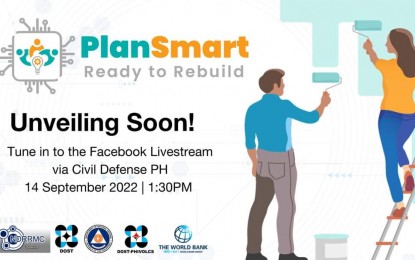
(Photo courtesy of Office of Civil Defense Facebook page)
MANILA – The government's science and disaster response agencies together with the World Bank (WB) will launch the "PlanSmart Ready to Ready Rebuild" web application on Sept. 14.
"The PlanSmart Ready to Rebuild web app is an automated planning tool envisioned to revolutionize the disaster risk reduction and management (DRRM) planning processes in the country by helping the government, especially the local government units (LGUs), to more efficiently plan for disasters, work smarter, and rebuild forward faster," the Office of Civil Defense said in a Facebook post on Sunday.
Partnering with the WB in this initiative are the National Disaster Risk Reduction and Management Council (NDRRMC) through the Department of Science and Technology (DOST), the Philippine Institute of Volcanology and Seismology (Phivolcs) and the Office of Civil Defense (OCD).
“We developed the PlanSmart Ready to Rebuild app to become a catalyst for more efficient and effective planning. Through the app, LGUs now have tools that will enable them to access and process data-driven information relevant to DRRM planning in a timely manner. The process of creating a local RRP, which usually takes months, can now be done more swiftly and efficiently,” DOST Secretary Renato U. Solidum Jr. said.
The app will empower LGUs to formulate their Rehabilitation and Recovery Plan (RRP) faster and improve decision-making and planning for pre- and post-disaster events.
It leverages the GeoRiskPH Integrated Platform and the Ready to Rebuild (R2R) Program, auto-generating a Rehabilitation and Recovery Plan through a pro-forma RRP document template.
“The PlanSmart Ready to Rebuild app is the first installment of PlanSmart tools that DOST, in collaboration with our partners, is currently developing. We remain committed to the vision that these automated tools will inspire a science-based and data-driven approach to governance,” Solidum added.
Through the R2R Program, about 1,800 participants from 350 LGUs and national government agencies beefed up their capacity and developed their respective RRPs even before natural and human-induced disasters happen.
The program covered pre-and post-disaster activities from gathering baseline disaster data, formulating an RRP and its subsequent financing and implementation, facilitating emergency procurement, crafting a communications strategy, and instituting monitoring and evaluation mechanisms.
“We are committed to continuously supporting the Philippine Government in its efforts to achieve a more responsive and efficient disaster rehabilitation and recovery planning. LGUs and communities, especially those most at risk, can greatly benefit from tools like the PlanSmart Ready to Rebuild web app and be empowered to take charge of their resilient recovery from disasters,” said Ndiamé Diop, WB director for the Philippines, Malaysia, Thailand, and Brunei.
The launch of the PlanSmart app also signals the beginning of a series of training activities designed to enable LGUs, particularly data managers, DRRM officers, planning officers, and other staff involved in disaster rehabilitation and recovery programs to learn how to use the app for the creation of their local RRPs. In its pilot run, the training program will build the capacities of more than 400 individuals from 137 LGUs in the National Capital Region, Region 4-A (Calabarzon), Bicol, Central Visayas, and Caraga.
“This training program is a valuable learning opportunity for our LGUs that are at the forefront of mitigating and managing disaster risks. It is our hope that the PlanSmart Ready to Rebuild app and the complementary capacity-building program will enable local decision-makers and planners to be prepared even before calamities strike. More importantly, we hope to empower them to build back better, faster, and more resiliently,” NDRRMC executive director and OCD administrator Undersecretary Raymundo Ferrer said.
The pilot LGUs will include graduates of the R2R Program, those that have existing GeoRiskPH memorandum of agreement with DOST-Phivolcs, and those that are most vulnerable to climate change and disasters as identified by the Cabinet Cluster on Climate Change Adaptation, Mitigation and Disaster Risk Reduction. (PNA)
